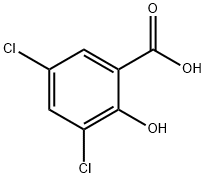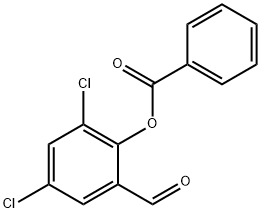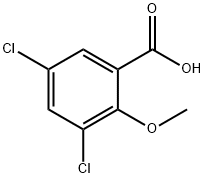3,5-DICHLOROSALICYLALDEHYDE
- CAS NO.:90-60-8
- Empirical Formula: C7H4Cl2O2
- Molecular Weight: 191.01
- MDL number: MFCD00003320
- EINECS: 202-005-5
- SAFETY DATA SHEET (SDS)
- Update Date: 2025-07-24 18:13:54

What is 3,5-DICHLOROSALICYLALDEHYDE?
Chemical properties
pale yellow crystalline powder
The Uses of 3,5-DICHLOROSALICYLALDEHYDE
3,5-Dichlorosalicylaldehyde has been used in the preparation of Schiff base ligands and (RS)-3,5-dichloro-2-[[(1-phenylethyl)imino]methyl]phenol.
The Uses of 3,5-DICHLOROSALICYLALDEHYDE
3,5-Dichlorosalicylaldehyde has been used in the preparation of:
- Schiff base ligands
- (RS)-3,5-dichloro-2-[[(1-phenylethyl)imino]methyl]phenol
Properties of 3,5-DICHLOROSALICYLALDEHYDE
| Melting point: | 95-97 °C (lit.) |
| Boiling point: | 273.68°C (rough estimate) |
| Density | 1.4410 (rough estimate) |
| refractive index | 1.4590 (estimate) |
| storage temp. | Inert atmosphere,Room Temperature |
| solubility | ethanol: soluble5%, clear, faintly yellow to greenish-yellow |
| form | Crystalline Powder |
| pka | 6.27±0.23(Predicted) |
| color | Pale yellow |
| Water Solubility | Insoluble in water. Solubility in methanol is almost transparent. |
| Sensitive | Air Sensitive |
| BRN | 973391 |
| CAS DataBase Reference | 90-60-8(CAS DataBase Reference) |
| EPA Substance Registry System | Benzaldehyde, 3,5-dichloro-2-hydroxy- (90-60-8) |
Safety information for 3,5-DICHLOROSALICYLALDEHYDE
| Signal word | Warning |
| Pictogram(s) |
 Exclamation Mark Irritant GHS07 |
| GHS Hazard Statements |
H315:Skin corrosion/irritation H319:Serious eye damage/eye irritation H335:Specific target organ toxicity, single exposure;Respiratory tract irritation |
| Precautionary Statement Codes |
P261:Avoid breathing dust/fume/gas/mist/vapours/spray. P264:Wash hands thoroughly after handling. P264:Wash skin thouroughly after handling. P271:Use only outdoors or in a well-ventilated area. P280:Wear protective gloves/protective clothing/eye protection/face protection. P302+P352:IF ON SKIN: wash with plenty of soap and water. P305+P351+P338:IF IN EYES: Rinse cautiously with water for several minutes. Remove contact lenses, if present and easy to do. Continuerinsing. |
Computed Descriptors for 3,5-DICHLOROSALICYLALDEHYDE
3,5-DICHLOROSALICYLALDEHYDE manufacturer
JSK Chemicals
3Y
Phone:+91-9879767984
Whatsapp: +91-9879767970
product: 3,5-Dichlorosalicylaldehyde, 98% 99%
New Products
4,4-Difluoropiperidine hydrochloride tert-butyl 9-methoxy-3-azaspiro[5.5]undecane-3-carboxylate Indole Methyl Resin N-Isopropylurea N,N-Dicyclohexylcarbodiimide(DCC) MELDRUMS ACID 5-METHYLISOXAZOLE-4-CARBOXYLIC ACID Magnessium Bis glycinate Zinc ascorbate 1-bromo-2-butyne 2-acetamidophenol 9(10H)-anthracenone Erythrosin B, 4-Piperidinopiperidine 2-((4-morpholinophenylamino) (methylthio) methylene) malononitrile 2,4-dihydroxybenzaldehyde 3-(4-morpholinophenylamino)-5-amino-1H-pyrazole-4-carbonitrile Methyl 2-methylquinoline-6-carboxylate 2,6-dichloro-4-nitropyridine 4-Bromo-2-chlorobenzonitrile 2-(benzylamino)acetic acid hydrochloride 4-(tert-Butoxycarbonylamino)but- 2-ynoic acid 3,4-dihydro-2H-benzo[b][1,4]dioxepine 1-Phenyl-1-cycloprppanecarboxylicacidRelated products of tetrahydrofuran







![(S)-RACLOPRIDE, [METHOXY-3H]](https://img.chemicalbook.in/StructureFile/ChemBookStructure2/GIF/CB3175011.gif)
You may like
-
 3,5-Dichlorosalicylaldehyde, 98% 99%View Details
3,5-Dichlorosalicylaldehyde, 98% 99%View Details
90-60-8 -
 3,5-Dichlorosalicylaldehyde, 99% CAS 90-60-8View Details
3,5-Dichlorosalicylaldehyde, 99% CAS 90-60-8View Details
90-60-8 -
 3,5-Dichlorosalicylaldehyde CAS 90-60-8View Details
3,5-Dichlorosalicylaldehyde CAS 90-60-8View Details
90-60-8 -
 3,5-Dichlorosalicylaldehyde CAS 90-60-8View Details
3,5-Dichlorosalicylaldehyde CAS 90-60-8View Details
90-60-8 -
 3,5 - Dichlorosalicylaldehyde, Packaging Size: 5 KgView Details
3,5 - Dichlorosalicylaldehyde, Packaging Size: 5 KgView Details
90-60-8 -
 90-60-8 98%View Details
90-60-8 98%View Details
90-60-8 -
 20677-73-0 (2,2-diethoxyethyl)methylamine 98%View Details
20677-73-0 (2,2-diethoxyethyl)methylamine 98%View Details
20677-73-0 -
 3-(4-(hydroxyamino)-1-oxoisoindolin-2-yl)piperidine-2,6-dione 98%View Details
3-(4-(hydroxyamino)-1-oxoisoindolin-2-yl)piperidine-2,6-dione 98%View Details
Statement: All products displayed on this website are only used for non medical purposes such as industrial applications or scientific research, and cannot be used for clinical diagnosis or treatment of humans or animals. They are not medicinal or edible.
